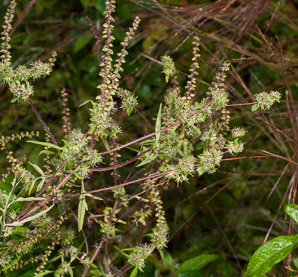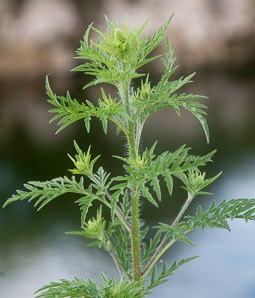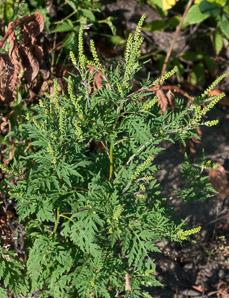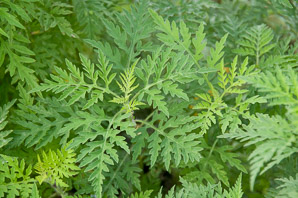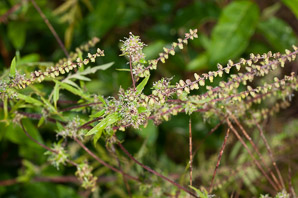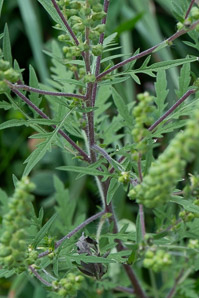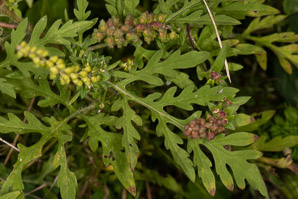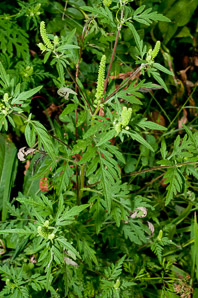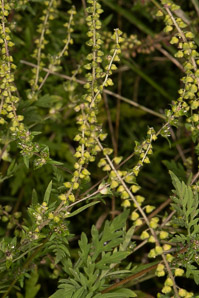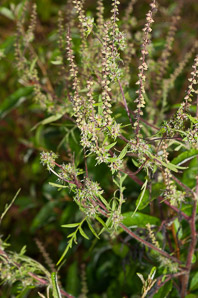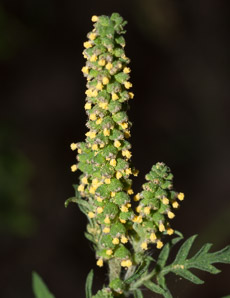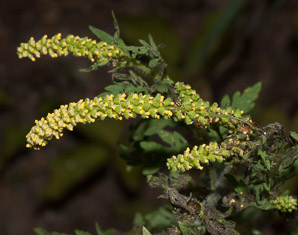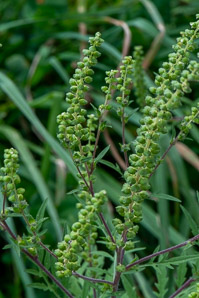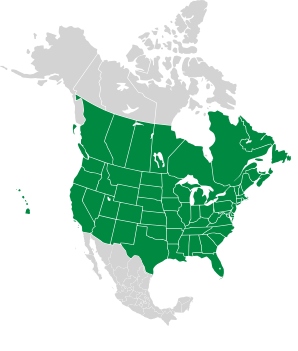
|
Ambrosia artemisiifolia L. Common ragweed, ragweed, bitterweed, annual ragweed, roman-wormwood, blackweed, carrot weed, hay fever weed, stammerwort, stickweed, tassel weed, American wormwood
Nobody seems to know why ragweed, best known for bedeviling allergy sufferers worldwide, is a member of genus Ambrosia, the Greek food of the gods said to be responsible for the gods' immortality. Perhaps, as this Wikipedia article suggests, the name simply refers to ragweeds' own apparent immortality: they are robust competitors considered by many to be invasive, and are among the few plants that show up on more noxious weed lists than on naturalist web sites. Ragweed is a North American native plant. Identification: Plants are 8-79″ (20-200 cm) tall, with stems that are green, pink-purple, or purple-spotted, with long, rough hairs. They are fairly easy to miss—even when in flower, they tend to blend in with their surroundings. Leaves are deeply divided, a bit similar to carrot leaves, 1½-4″ (4-10 cm) long, pinnate or bipinnate. Flowerheads are long (1-4″ (2.5-10 cm)) and narrow, covered with tiny yellow flowers 1/16-⅛″ (2-4 mm) in size. At first the flowers are green. Medical: Goldenrods, the widespread, showy, yellow-topped weeds, are often blamed for causing allergies because they disperse pollen at the same time that ragweed does. But ragweed is the culprit. As for medicinal benefits for ragweed, I wasn't able to find any. Online References:
The Virginia Tech Weed Identification Guide Wildflowers of the United States 9/14/2009 · Near Nashoba Hospital, Ayer, Massachusetts · ≈ 15 × 10″ (39 × 26 cm) 4/15/2015 · Florida · ≈ 4 × 6″ (10 × 15 cm) 8/11/2010 · Nashua River Rail Trail, Groton Center, Groton, Massachusetts · ≈ 12 × 17″ (29 × 44 cm) 4/15/2015 · Florida · ≈ 7 × 4½″ (17 × 11 cm) 9/14/2009 · Near Nashoba Hospital, Ayer, Massachusetts · ≈ 8 × 5″ (19 × 13 cm) 8/30/2021 · Woodward Point Preserve, Brunswick, Maine · ≈ 4 × 6″ (10 × 15 cm)
Ambrosia artemisiifolia description by Thomas H. Kent, last updated 11 Jul 2023. © FloraFinder.org. All rights reserved. |
9/17/2021 · Woodward Point Preserve, Brunswick, Maine · ≈ 6 × 4″ (16 × 10 cm) 8/4/2010 · Nashua River Rail Trail, Groton Center, Groton, Massachusetts · ≈ 8 × 12″ (20 × 31 cm) 9/17/2021 · Woodward Point Preserve, Brunswick, Maine · ≈ 4½ × 7″ (11 × 16 cm) 9/14/2009 · Near Nashoba Hospital, Ayer, Massachusetts · ≈ 7 × 11″ (18 × 27 cm) 8/18/2010 · J. Harry Rich Woods, off Nod Rd., Groton, Massachusetts · ≈ 2½ × 3½″ (6.6 × 9.8 cm) 8/18/2010 · J. Harry Rich Woods, off Nod Rd., Groton, Massachusetts · ≈ 5 × 3½″ (13 × 9.2 cm) 8/30/2021 · Woodward Point Preserve, Brunswick, Maine · ≈ 4½ × 7″ (11 × 16 cm) Range:
|
